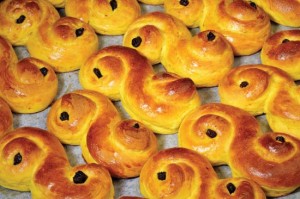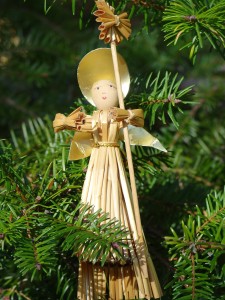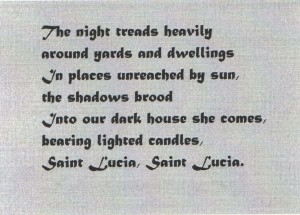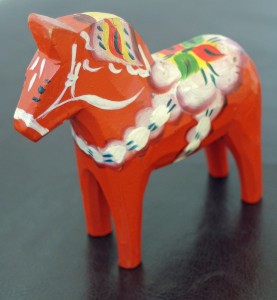Posts Tagged ‘St. Lucia’
A Swedish Christmas in London
Last week we went to a Swedish party – the St. Lucia festival, I wrote to my parents from England in mid-December 1962. The background of it seems somewhat confused – the story of a saint mixed up with old pagan mid-winter rites.
My confused reaction to this experience opened me to the concept of cultural adaptation: the way stories and beliefs from one tradition are assimilated into another. Growing up as a Christian in New Zealand, where the seasons are the opposite of the Northern Hemisphere, I was aware of an odd disconnect in the trappings of our festivals, but as yet did not fully comprehend why this should be.

Saffron bread (lussekatter), traditionally served on St. Lucia’s Day. Image from Encyclopedia Britannica.
The event was also a fun field trip for our group of Swedish language students at the College of Further Education in Slough, west of London. Tony and I had become enamored of all things Scandinavian, and hoped to go there one day. Our teacher, Ingrid, the daughter of a diplomat based in London, was eager to introduce us to London’s Swedish community. I tried to summarize her explanation of the festival in my letter, which continues:
The cattle were slaughtered about Dec. 13 for Christmas, and the women used to come out early in the morning with the men’s breakfast. It developed into a ceremony in which a young girl, attended by maidens and young boys, & wearing a head-dress of candles on her head, goes early in the morning to the homes of people in the district bringing hot coffee. Apparently in Stockholm anyway it has developed into a sort of beauty contest, but in London the Swedes are more Swedish than at home & we saw a more genuine procession of children (the little boys looking very self-conscious) singing charming old Swedish carols, & all carrying candles in the darkened room. Very effective & beautiful. The evening finished with coffee & Swedish cakes & pastries at candle-lit tables.
I later learned that before the Christian west adopted the Gregorian calendar in the late 1500s, St. Lucia’s Day fell on the winter solstice, and that it originally honored a goddess who brings the light in the dark Swedish winters. Traces of this solstice celebration linger in the words of the carols sung by the children.
The event we attended at the Swedish church in London also included a crafts fair, which I wrote about for my New Zealand newspaper. Here is the text:
SWEDISH CHRISTMAS DECORATIONS

The straw angel we bought at the church fair. Battered but loved, she still graces the top of our tree.
Our Christmas tree will be decorated with a Swedish angel this year. She is made out of barley straw, pale shining gold pieces neatly tied together. In the early days in Sweden, when the floors of homes were covered with straw to keep out the bitter cold, Christmas guests used to play with the shining straws, plaiting and twisting them into quaint figures. Now Swedish houses are centrally heated, but the custom has persisted, and wherever in the world Swedish people live, at Christmas their homes are always decorated with the golden figures and wreaths.
The Swedish community in London recently held their annual church fair, and out came the traditional Christmas gifts and decorations. As well as the charming angels, there were straw animals, goats and horses and dogs, and handsome plaited wreaths for hanging at the door. Other figures were turned or carved out of wood, and brightly painted. Particularly impressive were ranks of glowing red wooden horses in varying sizes, each painted with gaily decorated harness. Very thin pieces of wood were carved into the tails and wings of formalized birds. By contrast with the tinsel and glitter of English decorations, these traditional designs have a striking simplicity of line and a quaint charm that is refreshing and timeless.
Maureen is exploring an old black filing cabinet that contains 55 years of her papers and memorabilia.

